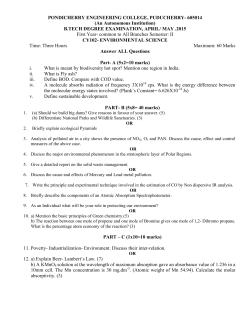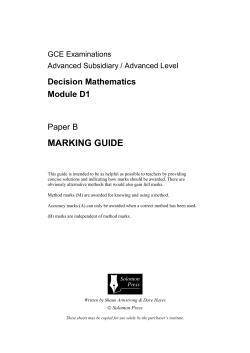
Sample Midterm Exam Duration: 2 Hours
Sample Midterm Exam Duration: 2 Hours This sample test includes 2 pages and 6 questions. Special Instructions: course notes are allowed. Problem 1 (5 marks): A mole of an ideal gas expands according to the law PV γ −4 / 3 = const . (a) Determine whether its temperature goes up or down. (b) What is the heat capacity of the gas during this process? Problem 2 (4 marks): The temperature on a certain summer day is 30°C. The relative humidity is 90%. (a) What is the absolute humidity (the actual amount of water vapor in the air)? (b) What would be the relative humidity if by somehow we doubled the actual amount of water vapor in the air (keeping temperature the same)? The saturated vapor pressure at T = 30 o C is P = 4.2 kPa. Consider water vapor to be an ideal gas. Problem 3 (6 marks): The specific heat capacity of Albertson’s Rotini Tricolore is approximately 1.8 J/g°C. Suppose you toss 340 g of this pasta (at 25° C) into 1.5 liters of boiling water. The specific heat capacity of water is 4.2 J/ g °C. (a) What will be the temperature of the water (before there is time for the stove to provide more heat)? (b) What is the change in the entropy of the universe (before there is time for the stove to provide more heat)? Problem 4 (10 marks): The Otto cycle consists of four steps: 1-2-3-4-1, where 1-2 is adiabatic compression from V1 = 50 liters to V2 = 10 liters, 2-3 is isochoric process (pressure goes up), 3-4 is adiabatic expansion from V2 = 10 liters to V1 = 50 liters correspondingly, 4-1 is isochoric process (pressure goes down). (a) Draw this cycle in PV coordinates. (b) Assuming that the working substance is an ideal gas, calculate the efficiency of this cycle. (c) Draw this cycle in T S coordinates. (d) What is the change in the entropy of a monatomic ideal gas for each step of this cycle? Problem 5 (7 marks): Calcium carbonate CaCO3 has two common crystalline forms, calcite and aragonite. You have a data table at room temperature (T = 298 K) and pressure P = 1 atm for the Gibbs free energy, volume, and entropy per one mole of these two phases: G (kJ/mol) V (cm3/mol) S (J/mol K) Calcite -1128.8 36.93 92.9 Aragonite -1127.8 34.15 88.7 (a) Which one is stable at room temperature and atmospheric pressure, calcite or aragonite? (b) Calculate the pressure (still at room temperature) at which the other phase should become stable. (c) What is the difference between the Gibbs free energies (per one mole) of calcite and aragonite, ∆ G = Gc − Ga at T = 298 K and P = 4000 atm ? Problem 6 (8 marks): Define the heat capacity of any object at constant volume and constant pressure. Derive a formula C P − CV for any object in terms of P, V, T.
© Copyright 2025





















